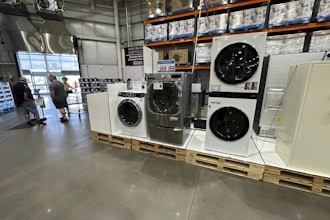
TEMPE, Ariz. — Economic activity in the manufacturing sector contracted in March after two consecutive months of expansion preceded by 26 straight months of contraction, say the nation's supply executives in the latest Manufacturing ISM Report On Business.
The report was issued Tuesday by Timothy R. Fiore, CPSM, C.P.M., Chair of the Institute for Supply Management Manufacturing Business Survey Committee:
"The Manufacturing PMI registered 49 percent in March, 1.3 percentage points lower compared to the 50.3 percent recorded in February. The overall economy continued in expansion for the 59th month after one month of contraction in April 2020. (A Manufacturing PMI above 42.3 percent, over a period of time, generally indicates an expansion of the overall economy.) The New Orders Index contracted for the second month in a row following a three-month period of expansion; the figure of 45.2 percent is 3.4 percentage points lower than the 48.6 percent recorded in February. The March reading of the Production Index (48.3 percent) is 2.4 percentage points lower than February's figure of 50.7 percent. The index dropped back into contraction after two months of expansion, with eight months of contraction before that. The Prices Index surged further into expansion (or 'increasing') territory, registering 69.4 percent, up 7 percentage points compared to the reading of 62.4 percent in February. The Backlog of Orders Index registered 44.5 percent, down 2.3 percentage points compared to the 46.8 percent recorded in February. The Employment Index registered 44.7 percent, down 2.9 percentage points from February's figure of 47.6 percent.
"The Supplier Deliveries Index indicated a continued slowing of deliveries (though at a slightly slower rate of change), registering 53.5 percent, 1 percentage point lower than the 54.5 percent recorded in February. (Supplier Deliveries is the only ISM Report On Business index that is inversed; a reading of above 50 percent indicates slower deliveries, which is typical as the economy improves and customer demand increases.) The Inventories Index registered 53.4 percent, up 3.5 percentage points compared to February's reading of 49.9 percent. The index returned to expansion after six months of contraction.
"The New Export Orders Index reading of 49.6 percent is 1.8 percentage points lower than the reading of 51.4 percent registered in February. The Imports Index continued in expansion in March, though just barely, registering 50.1 percent, 2.5 percentage points lower than February's reading of 52.6 percent.
"In March, U.S. manufacturing activity slipped into contraction after expanding only marginally in February. The expansion in both February and January followed 26 consecutive months of contraction. Demand and output weakened while input strengthened further, a negative for economic growth. Indications that demand weakened include: the (1) New Orders Index falling further into contraction territory, (2) New Export Orders Index dropping into contraction, (3) Backlog of Orders Index contracting at a faster rate, and (4) Customers' Inventories Index remaining in 'too low' territory. Output (measured by the Production and Employment indexes) also weakened. Factory output (production) contracted in March, indicating that panelists' companies are revising production plans downward in the face of economic headwinds. The Employment Index moved deeper into contraction, as panelists' companies continued to release workers. Companies continued to cite 'attriting down' as the best process, as opposed to layoffs. Inputs — defined as supplier deliveries, inventories, prices and imports — expanded. All four indexes indicated expansion, which is not a positive sign when demand is moving in the opposite direction. Inventories growth is a temporary move to avoid tariffs and will decline when such trade issues are resolved.
"Demand and production retreated and destaffing continued, as panelists' companies responded to demand confusion. Prices growth accelerated due to tariffs, causing new order placement backlogs, supplier delivery slowdowns and manufacturing inventory growth. Forty-six percent of manufacturing gross domestic product (GDP) contracted in March, up from 24 percent in February. The share of manufacturing sector GDP registering a composite PMI calculation at or below 45 percent (a good barometer of overall manufacturing weakness) was 7 percent in March, a 5-percentage point increase compared to the 2 percent reported in February. Of the six largest manufacturing industries, three (Petroleum & Coal Products; Computer & Electronic Products; and Transportation Equipment) expanded in March, one fewer than in February."
The nine manufacturing industries reporting growth in March — listed in order — are: Textile Mills; Petroleum & Coal Products; Fabricated Metal Products; Primary Metals; Computer & Electronic Products; Nonmetallic Mineral Products; Transportation Equipment; Electrical Equipment, Appliances & Components; and Miscellaneous Manufacturing. The seven industries reporting contraction in March, in order, are: Wood Products; Paper Products; Plastics & Rubber Products; Furniture & Related Products; Chemical Products; Food, Beverage & Tobacco Products; and Machinery.
WHAT RESPONDENTS ARE SAYING
"Complex markets saw a surge in volume buying in anticipation of 2025 being slightly better than 2024. In March, however, all markets saw a slowdown, with fear and inventory stocking to hold through a potential crisis." [Chemical Products]
"Acute shortages continue to impact supply chain continuity. Chinese restrictions on critical minerals such as germanium have caused major shortages, resulting in all supply needed in 2025 already assumed — and, not surprisingly, significant price increases as a result. Tariffs are causing minor ripples at the moment in securing supply, with purchase order terms narrowing due to uncertainties. A&D (aerospace and defense), which has been very resilient, is starting to see questionable medium- to long-term demand due to governmental policy, including retaliatory actions taken by foreign countries with foreign military sales." [Transportation Equipment]
"Customers are pulling in orders due to anxiety about continued tariffs and pricing pressures." [Computer & Electronic Products]
"Starting to see slower-than-normal sales in Canada, and concerns of Canadians boycotting U.S. products could become a reality." [Food, Beverage & Tobacco Products]
"Business condition is deteriorating at a fast pace. Tariffs and economic uncertainty are making the current business environment challenging." [Machinery]
"New order levels have increased and are better than expected. We suspect that our customers are trying to build inventory at current prices to get ahead of expected tariff and related cost increases. We expect this surge in demand to be short-lived." [Fabricated Metal Products]
"Demand has been stable, consistent with last year. No evidence of growing demand. Tariff impacts and mitigation strategies are a daily conversation." [Electrical Equipment, Appliances & Components]
"Newly implemented tariffs are significantly impacting gross profits. Canada's new tariffs on U.S. goods are significantly impacting orders from that country. Quotes and sales are lower from Europe due to the threat of retaliatory tariffs." [Miscellaneous Manufacturing]
"Worldwide economic instability has really begun to impact our oil and gas business. Aside from the change in the U.S. administration, the economies of China, India and Europe are drivers in what we believe is the next cyclical trough." [Petroleum & Coal Products]
"Bearish market sentiment and tariff applications and costs have dominated discussions over the past month and should continue to dominate markets until a clear path forward is determined. Overall concern is whether or not demand destruction will occur with higher pricing." [Primary Metals]






















